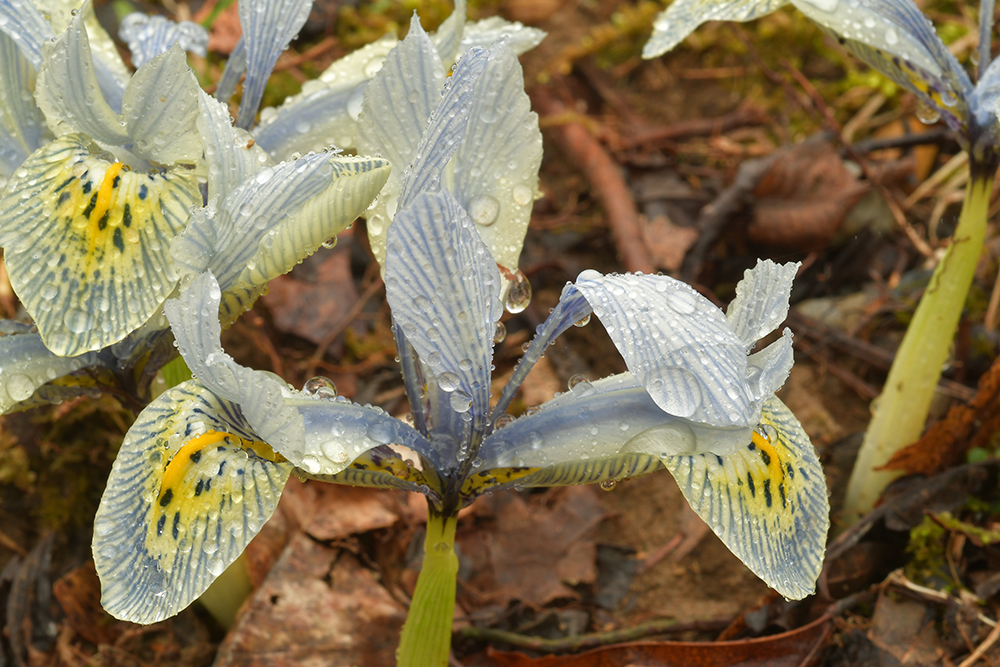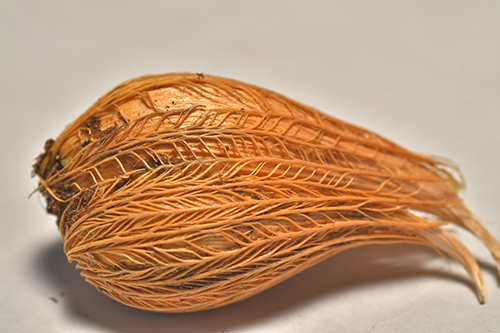
Without question, March is a fickle month. Known for beginning as winter and ending as spring, it has also been known to start as spring and end with a snowstorm! Plants which bloom during this month are known for their resilience to extremes in weather. What is even more amazing is how delicate the flowers of many of these plants appear. To me, Iris have some of the most endearing and complex flowers a gardener can enjoy and incredibly, two of the bulbous Iris bloom in March!
Iris is a member of its own family, the Iridaceae with upwards of 300 species spanning Europe into Asia and North America. The name was first penned by the Swedish botanist Carl Linnaeus (1707–1778) in 1753. The name comes from the Greek Ris, meaning rainbow and describes the glorious rainbow of floral colors showcased within this group of plants. Iris reticulata, commonly known as the Netted Iris is the March blooming species most common to gardens. It was discovered and named by Friedrich August Marschall von Bieberstein (1768–1826) and published in 1808. Initially von Bieberstein served in the military before transitioning to the aide-de-camp for the Russian General Count Kochovoski, followed by other jobs that allowed him to travel and collect 'new' plants throughout present day Ukraine and the Caucasus. Although this Iris was initially found in the Caucasus, it is also native to Turkey, northeastern Iraq, as well as northern and western Iran. The species epithet means netted and refers to the net-like appearance of the outer covering or tunic of the bulb, as seen in Picture 1. A netted tunic is in fact found in several different Iris species, spurring botanists to create a special section for this group entitled Reticulatae.
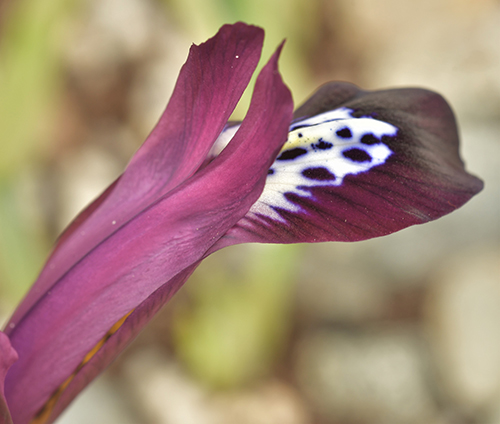
Iris reticulata grows from a true bulb, consisting of layers of modified leaves filled with carbohydrates to sustain the plant while dormant during the hot dry summers and cold winters. If cut in half, they will resemble the layers of an onion, which is also a bulb. At the bottom is a basal plate from which the roots emerge and, as noted above, the bulb is covered by a protective netted tunic. The function of a tunic is to help reduce dehydration of the layers of leaves within. The bulbs typically have blue to dark purple flowers, with the three individual petals and three sepals appearing far more slender and delicate than many Iris. Like most Iris, the fascination with the flower is over its intricacy and sheer beauty, all designed for attracting pollinators and preventing self-pollination.
The flowers consist of three long, horizontal or slightly drooping 'petals', which are actually not petals but modified leaves called sepals and three upwardly oriented true petals. Among Iris aficionados, the sepals are commonly referred to as the falls, while the petals are the standards. Both measure around 2" in length when held outstretched, yielding a flower around 2½–3½” in diameter. The falls typically have a brightly colored central blotch of white or orangey yellow that is called a signal. Running from the outer margins of the falls towards the central base are white to dark purple nectar guide lines (Picture 2). Immediately above the falls is a petal-like structure called the style arm that also serves to give the flower a much fuller appearance. The style is the female portion of a flower that connects the pollen receptive tip or stigma to the ovary. In most flowering plants the style serves to provide little to no floral interest, but Iris is an exception! The outer tip of the style arm is split into two, ear-like lobes and curls upward into a lip (Picture 2) with the pollen receiving stigma and anthers located beneath the arm. The illustration below shows the style arms cut in half, revealing the structures below the arm. The stigma appears just behind the lip and is covered by a stigmatic flap that is 'hinged' at the lower or proximal edge. Closer to the center of the flower are the pollen releasing anthers. Finally, near the center of the flower and at the base of the filaments or stems that supports the anthers lies the pollinator's ultimate goal – the sugary nectar glands.
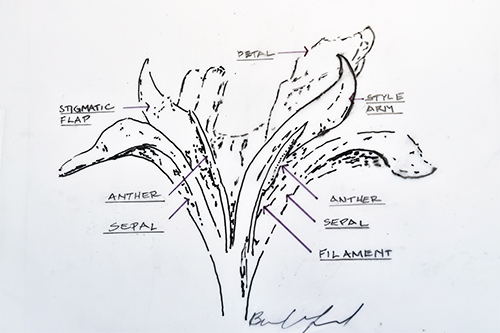
The entire floral design is structured to lure pollinators towards a sweet nectar reward, while ensuring pollen is transferred from another flower onto the stigma. The horizontally oriented falls act as a pollinator landing pad and the showy signal combined with the colorful nectar guide lines help to attract and direct the pollinator under the style arm towards the nectar glands. As it passes under the stigmatic flap, the rubbing action of the forward moving pollinator serves to pull the flap open, depositing pollen from a previously visited flower onto the stigma. The nectar glands continue to lure the insect further in and as it passes under the anthers, pollen is deposited on the back of the insect from the anthers. Upon backing out from under the style arm, the stigmatic flap is pushed shut, preventing self-pollination. Plants resulting from self-pollination, which is the transfer of a flowers' own pollen onto its own stigma are much weaker than those originating from cross pollination, which explains the intricate design to avoid this occurrence. Upon landing on a new flower, the insect once again pushes the stigmatic flap open, transferring pollen from its back to the sticky surface of the stigma and the cycle of cross pollination is complete. In addition, the style arm protects the anthers and stigma from any potential damage due to poor weather. An engineering marvel!

The flowers typically reach 6–8” tall and are lightly fragrant. The spear-like, four sided green foliage is initially as tall as or slightly taller than the flowers, but stretches to 12–15” once flowering is complete. Care must be taken to site the plants properly, since the spikey foliage can be somewhat distractive to a gardens' composition before going dormant in early June. The cultivar 'Violet Beauty' (Picture 4) has deeper purple flowers with a complimentary orange signal while 'Harmony' (Picture 5) is a readily available blue flowered selection with a white signal. A hybrid that I have only recently discovered is 'Katherine Hodgkin'. Bred by the famed British horticulturist, E.B. Anderson, he named the plant after the wife of a fellow garden enthusiast, Eliot Hodgkin. As seen in Picture 6 at the article's end, the plant is a vigorous grower and provides sturdy flowers year after year. It features white petals with lacey blue lines, while the falls feature an attractive yellow blotch with blue lines and central dots.
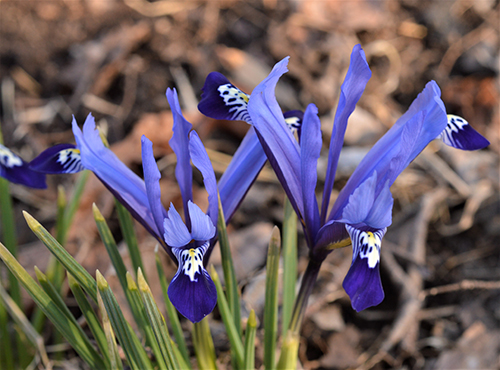
Less frequently seen in gardens with its bright yellow flowers is Iris danfordiae or Danford Iris (Picture 6). Initially named Xiphion danfordiae in 1876 by the English botanist John Gilbert Baker (1834–1920), it was properly assigned to the genus Iris in 1882 by the Swiss botanist and mathematician Pierre Edmond Boissier (1810–1885). The species epithet honors Mrs. Antoinette Emily Dyce Danford (1845–1927), an indefatigable plant hunter who found the plant in the Southern Anatolia region of Turkey in March of 1876. She has been described as indefatigable, since she was 26 weeks pregnant when she found the plant! Unfortunately, other than being a resident of the UK, little is known about her life.
This Iris is only native to regions of Turkey and like it's previously described cousin, it too has a netted outer tunic. The bright yellow flowers appear in mid to late March and depending upon the year, they coincide with or bloom slightly earlier than Iris reticulata. The flower structure differs since the standards are actually reduced to small hairs, almost too small to see while the style arm is enlarged and once again split into two prominent ear-like lobes that arch over the top of the falls (Picture 6). The arching form and positioning of the style arms creates a tube or funnel-like appearance. Each of the three 'tubes' is about 1½” long with the anthers and stigma inconspicuously located under the style arm. On the outside of the style arms, two parallel dark green lines appear along the center. The falls have green speckling near the base with a deeper yellow to orange central ridge along the lower ⅔ of the falls, with the terminal (upper) ⅓ reflexed downward. Flowers have an attractive honey-like fragrance to help lure-in those early rising pollinators.
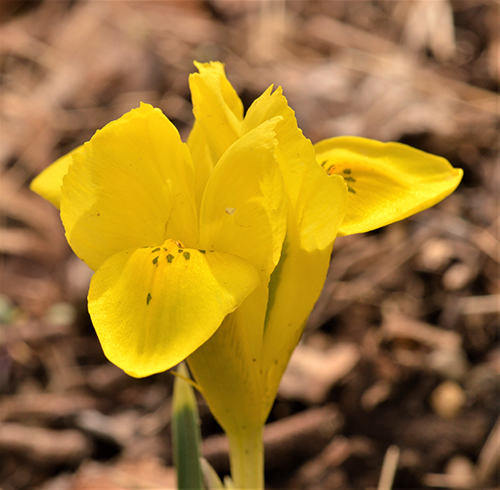
Similar to Iris reticulata, the foliage is once again 4-sided, but it emerges slightly later and is barely apparent when the plants are in bloom. Each bulb produces two, spear-like leaves and once the flowers fade, the leaves extend fully to 8–10" in length. The biggest challenge with growing Danford Iris is getting it to rebloom! When planted to the normal depth of 3–4", the original bulb produces a number of offsets, all too small to flower in the coming year. Usually, after 5–10 years, some of the offsets will have grown to a sufficient size to allow flowers to once again develop. Some sources suggest planting the bulbs deeper, as the deeper depth often reduces the tendency of bulbs or corms to produce offsets. Other sources suggest digging up both I. reticulata and I. danfordiae bulbs annually, separating the smaller bulbs and replanting. From my experience, the bulbs of both species will rebloom without being dug and replanted, although Iris reticulata will rebloom more frequently, most on an annual basis. By installing 5–10 bulbs per hole, located 6–12" apart there will be a sufficient number of bulbs to ensure flowering for 30+ years without replanting.
Both species appreciate full sun and well-drained soils in zones 5–9. They also appreciate a soil that is near neutral or slightly alkaline, benefitting from an annual addition of some lime should the soil be inherently acidic. Both species naturally grow in exposed and gravely soils, suggesting a layer of fine gravel or grit would be the most appropriate mulch for the plants. They require little effort to grow, although plantings of I. danfordiae would benefit from the addition of new bulbs each fall until the cycle is achieved whereby the oldest bulbs obtain sufficient size to start reblooming.
Plants that endure the often brutal weather conditions of March are willing to risk the cold due to the minimal amount of floral competition for the early spring pollinators. These two sweetly scented Iris species provide wonderful color for the spring garden and even though they are certainly not native, they can still provide nourishment for our newly awakened pollinators. Often overlooked for the better known early blooming bulbs, they should be near the top of your bulb wish list for next fall. In addition, keep your eyes peeled for very attractive crosses between these two species that are available from small, specialty nurseries. Without doubt, these are very endearing flowers for a very fickle month!
